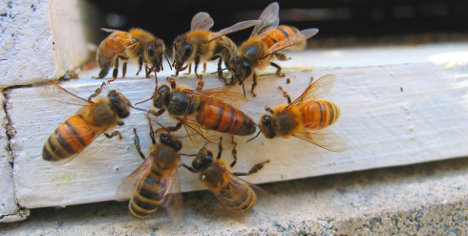By Jennifer Thompson

If it feels like you’ve been hearing a lot about bees lately, you have, and for good reason – bees are dying off in record numbers.
That matters, because one in every three foods we eat – more than one hundred fruits and vegetables – are dependent on bees for pollination. For Meaford food growers, it means a potential impact on crops like apples, berries, pears, alfalfa, and clover.
This spring stories abound of mass casualties suffered by commercial beekeepers in Ontario and throughout North America.
In Elmwood, Ontario, organic honey producer Dave Schuit reported the loss of an astounding thirty million bees from six hundred hives.
In Arkell, Ontario, longtime commercial beekeeper Tibor Szabo Jr lost forty nine of fifty hives.
In a retail parking lot in Willsonville, Oregon, fifty thousand bees dropped out the surrounding trees and littered the ground, writhing and dying.
Commercial beekeepers worldwide have been sounding the alarm about dwindling honeybee populations for years. Since 2006, bees have been dying off by the millions. The phenomenon is called Colony Collapse Disorder ( C.C.D.)
Beehives are complex systems, and a colony of bees depends on its ability to stay warm and fed through the winter in order to survive. The death of bees in the field means less food and warmth for the bees in the hive. Sickened bees that do return spread disease within the hive. A weakened hive over winter means fewer bees in the spring, resulting in a vicious circle of loss.
Many factors have been thought to contribute to C.C.D., including Varroa mites, parasites and viruses, a poor diet consisting of mainly of corn syrup, and pesticide use.
While they have learned to deal with the mites and other factors, beekeepers and scientists are increasingly pointing the finger at pesticide use as the major cause of bee deaths.
One of the suspected pesticides, Neonicotinoids, or neonics, is a class of pesticides which were developed to deal with sap-feeding insects such as aphids, and root-feeding grubs.
Originally used only in potato fields, they have been in much wider use since 2003.
Despite there being no studies on the effects of these products on non-target insects by the agencies which regulate their use, neonicotinoids are now the most widely used pesticide in the world.
Virtually all corn, soy, wheat, and canola seed is pretreated with these products, which are manufactured by Bayer CropScience and Syngenta.
When bees forage for food in and around fields that have been planted with treated seeds, their nervous systems are attacked, and they lose their ability to fly and navigate, which prevents them from returning to the hive. They die from poisoning and exposure. Those that do make it back to the hive bring the poison with them.
In the case in Oregon, cosmetic spraying of trees with neonicotinoids is believed to have resulted in almost instant bee mortality.
The Independent spoke with Dan Davidson, President of the Ontario Beekeepers Association. Together with the Quebec Beekeepers Association, his organization has put out a call for a complete ban of neonicotinoid use for field crops.
“There’s no research to prove that it greatly improves farmers’ yields, and if no farmer can use them they are all in the same boat. But if one farmer can use them, they’ll all want it. That’s the way it goes,” offered Davidson. “The scale (of use) that’s going on now is nothing close to where it started. It started out only in potato fields, very minimal use – now you can’t even get untreated seed – and we’re seeing an accumulation in the environment because they don’t break down very quickly.”
Davidson says that Quebec is further ahead of Ontario in studying the accumulation of neonicotinoids in the ecosystem.
“They are doing soil tests and water tests. It’s interesting: they tested sixteen different waterways and found neonics in every single one. It’s definitely getting out into the environment, no doubt about it. These pesticides are toxic to bees at less than four parts per billion,” Davidson told the Independent.
Although he maintains that Ontario hasn’t seen bee deaths at the level of Colony Collapse Disorder, “we came really close this spring with some areas in great jeopardy of collapsing. Maybe next year we’ll see that. I really hope not.”
In the past, beekeepers anticipated winter losses of roughly ten percent. In the last half dozen years, those losses have climbed steadily to an average of twenty-five to thirty percent loss and more.
“We’re trying to rally the berry growers and apple growers who depend on bees to call for a ban,” said Davidson.
On July 17, Davidson’s association is scheduled to sit down with OMAFRA and farm and chemical industry groups to begin discussion about this pressing issue.
“Maybe they just want to sit around and talk about it and not do anything. That will be pretty frustrating for us,” Davidson concluded.
Locally, apple growers are dependent on bees to pollinate their crops, but they also sometimes use neonicotinoids to control pests, so they are in a unique position to see both sides of the issue.
The Independent asked Brad Johnston, owner of Meaford’s Barbetta Orchards, for his perspective.
Johnston’s own bee supplier lost thirty percent of his hives this spring, and fifty percent last year, though he says he hasn’t as of yet experienced a dramatic increase in the cost of bringing bees to his orchard, or a decrease in their availability.
“I’m a firm believer in pollination,” Johnston offered. “I can’t stress how important this is. The bees pollinate almost one hundred kinds of fruit and vegetables and if we don’t have that, we have a real problem. It concerns me. I do what I can for my part.”
As an apple grower he uses neonicotinoids as part of his Integrated Pest Management (IPM) program. His orchard is monitored weekly and if there are pests he deals with them in a targeted way. Gone are the days when apple growers used pesticides according to the calendar; the IPM concept adopted by many growers is to only spray when necessary.
While he is hesitant to join in calling for a ban without knowing all the facts, Johnston concedes that if neonicotinoids are a problem, “I don’t have to use them. I can use something else. Life will go on.”
He says he has talked to other apple growers who have decided to stop using neonics altogether because they don’t want to contribute to the loss of bees. When asked if he would wait for a ban before he would stop using them, Johnston said, “I’ve already kind of made that decision, that I won’t be using it. We have a choice, we have other options.”
Johnston said that the loss of bees would impact his business.
“This would certainly impact me. I would have to make do with less. I would squeak by. I think it will affect the quality and quantity of the crops, bottom line. We will still have fruit, because of the fact that pollination can happen in different ways, but there will be smaller and more misshapen apples.”
Richard and Jane Elzby own Sunnyside Honey, a Meaford organic honey producer. Richard Elzby says that he has seen an increase in the number of bees he loses each year.
“My loss until 2007 when Colony Collapse started was one hive a year. This year, I lost thirty-three percent. Last year I lost twenty-five percent. The year before that it was twenty percent. Every year it gets worse,” explained Elzby. “Living in this area, we have all our crops pollinated by bees, especially our fruit crops. As long as we have the bees, we can increase the crop. If we don’t have the bees, then of course the crop is going to be really lacking.”
When asked about neonicotinoids, Elzby points out that, “It’s not just bees getting killed by this stuff. All the pollinators are killed by this product. It’s airborne and it gets into the dust and travels. You may as well be spraying Raid into the air, it’s that deadly to insects, including all of our pollinators like butterflies and hundreds of different types of pollinators people don’t even think of.”
“I was an environmental engineer and a chemist for twenty-five years. What I found in the chemical industry is that there is always an alternative. So if neonicotinoids are such a damaging chemical…there needs to be pressure put on these companies to do away with them, or change the formulas. Germany and France banned them three years ago and they have seen their bees come back. Major recoveries,” said Elzby.
The European Food Safety Authority published the results of a peer-reviewed study in January 2013. The results showed higher than acceptable risks to bees. In response, the European Commission recommended a moratorium. On April 29, 2013, fifteen of twenty-seven European Union member states voted to enact a two-year ban which will take effect December 1, 2013.
Although Colony Collapse Disorder has long been thought to be the result of several factors, not anymore, says Elzby.
“As far as beekeepers are concerned, this is our opinion: it’s the neonicotinoids that are doing it. The latency period for neonics is fifteen to twenty years. That’s how long it takes from the time it’s put in the market until they realize what the damage is. Like asbestos, and PCBs. They find out too late,” offered Elzby.
When asked what the impact on his business has been, Elzby told the Independent the projection is that the price of honey will need to increase, and that will impact sales. And he’s having to go further afield to find replacements for the hives he’s lost. The supplier he usually uses was not able to have the bees ready in time for him this year.
The question many are asking is what can be done?
In addition to advocating for a ban on neonicotinoid use here in Ontario, local organization Transition Meaford says that citizens can get to work in their own backyards by creating bee sanctuaries.
The Meaford Bee and Butterfly Habitat Initiative was started last year by Transition Meaford, a local group working toward community sustainability and resilience.
Lindy Iversen of Transition Meaford says that honeybees used by commercial beekeepers are not native to North America. They were imported from Europe in the 1600s.
There are seven hundred and thirty indigenous species of bees in Canada, with Ontario being home to four hundred of those. Native species are crucial for pollinating native flowering plants, such as pumpkins and watermelons, blueberries and cranberries, which are more efficiently pollinated by native bees than by honey bees.
Such diversity of plant life plays a role in the health of commercial honeybees by allowing for a healthy diet, which, just as in humans, improves immunity.
“The Meaford Bee and Butterfly Habitat Initiative aims to promote a grassroots move to have Meaford become a sanctuary for bees and butterflies and their friends, such as songbirds,”explained Iversen.
Existing habitats organized by Transition Meaford can be found at EcoInhabit, the Meaford Museum, the Columbarium at Meaford’s Lakeview Cemetery, and beside the greenhouse behind Foodland.











